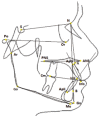Etiological factors in second mandibular molar impaction
- PMID: 24790715
- PMCID: PMC4002345
- DOI: 10.4317/jced.51382
Etiological factors in second mandibular molar impaction
Abstract
Objectives: The impaction of the second mandibular molar (MM2) has recently become more prevalent. Several etiological hypothesis have been proposed to investigate the association between skeletal features and impaction of MM2. The aims of this study were to analyze the skeletal features in patients with MM2 impaction and the association between arrested eruption of MM2 and the presence of the third mandibular molar (MM3).
Study design: In this retrospective study 48 subjects from 3,530 Caucasian orthodontic patients with MM2 impaction were included in a study group (SG) and compared to a control group (CG) of 200 subjects without MM2 impaction. Panoramic radiographs evaluated the presence or absence of the MM3 germ. Cephalometric analysis was performed to evaluate linear and angular skeletal values. For the statistical analysis, descriptive statistics, Student's t-test, χ2 test and odds ratio (OR) were used.
Results: The paired comparisons between SG and CG showed in cephalometric analysis both a reduced mandibular gonial angle (ArGoMe) and lowered Jarabak's polygon value with a statistically significant difference (P≤ 0.05). MM3 was statistically significant associated (P≤ 0.05) with MM2 impaction but it is not a risk factor (OR 0.817).
Conclusions: Subjects with MM2 impaction show a vertical condylar growth direction. MM3 is not a risk factor for MM2 impaction. Key words:Impacted mandibular second molar, skeletal features, orthodontic.
Conflict of interest statement
Figures
References
-
- Evans R. Incidence of lower second permanent molar impaction. Br J Orthod. 1988;15:199–203. - PubMed
-
- Cho SY, Ki Y, Chu V, Chan J. Impaction of Permanent Mandibular Second Molars in Ethnic Chinese Schoolchildren. J Can Dent Assoc. 2008;74:521e. - PubMed
-
- Shapira Y, Finkelstein T, Shapack N, Lai YH, Kuftinec MM, Vardimon A. Mandibular second molar impaction. Part I: Genetic traits and characteristics. Am J Orthod Dentofacial Orthop. 2011;140:32–7. - PubMed
LinkOut - more resources
Full Text Sources
Other Literature Sources

